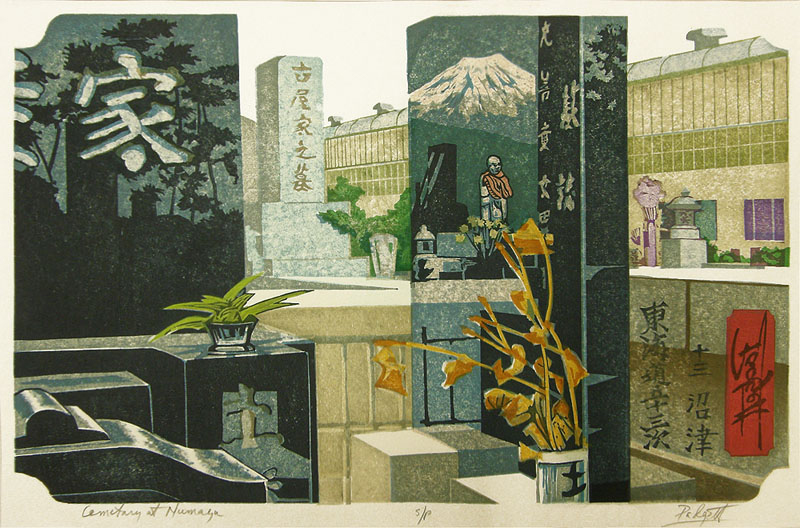Cemetery at Numazu is a color woodcut from 2006 by American artist, Walter Padgett. It is pencil signed, titled and edition s/p. Padgett carved his blocks and hand printed Cemetery at Numazu on ivory Echizen Kozo and the image measures 11-1/4 x 18 inches.
Cemetery at Numazu is number thirteen from the series Fifty-three Stations of the Tōkaidō (Tōkaidō Gojusan Tsugi). Padgett wrote about his color woodcuts: “Travel and adventure being essential to my selection of imagery, I consider myself a Western artist of the Pacific Rim, inspired by the landscape and cultures on both sides of the Pacific. As a woodblock printmaker I am also a follower of the Sosakuhanga Movement, in which the artist attempts to master all of the processes that for centuries were accomplished collaboratively by skilled artisans, each specializing in part of the process–publisher, carver, printer, paper prepare, marketer, salesman…I find pleasure in all stages–like image engineering–and am always delighted and surprised by the magical results.”
Walter Padgett, sculptor, painter, printmaker, photographer, and teacher, was born in North Carolina on 4 August 1945 and grew up in Atlanta, Georgia. He first studied architecture at Clemson University in South Carolina and then pursued the fine arts at Florida State University, earning his Bachelors and Masters of Fine Arts degrees in the field of sculpture. Padgett taught art at the high school level as well as at Florida A & M University in Tallahassee before moving to Oregon. In 1971, he joined the faculty of the newly opening Rogue Community College in Southern Oregon, where he was head of the art department for eleven years and taught full-time for over thirty years.
During these years Padgett continued to produce work in sculpture and painting but increasingly focused his attention on printmaking. In 1983, he took a two-year leave of absence to pursue studies in Japanese woodblock printmaking which included a month of intensive study at the Yoshida Hanga Academy in Tokyo. A pivotal point in his career was a two-month bicycle trip across Japan, documenting the famous Tokaido highway, and the associated prints of Hiroshige and Sekino. Padgett employs Japanese handmade chisels, brushes, and paper for his color woodcuts. He creates in the Sōsaku-hanga tradition, carving his own blocks and hand printing his woodcuts, and he has led many workshops on these techniques and has given demonstrations.
Padgett’s oils, watercolors, sculptures, and woodcuts have received many awards. In September of 2008, he was awarded the Takanabe Town Mayor's Prize for a woodblock print exhibited at the Takanabe Museum (Japan), in a traveling exhibition of prints from the prestigious Kyoto International Woodprint Association’s permanent collection. His work is featured in the current exhibition at the Wichita Art Museum and related catalog The International Block Print Renaissance: Then and Now.
Walter Padgett’s work is represented in the collections of the National Museum of Jordan, Amman; the Jordan Schnitzer Museum of Art, Eugene, Oregon; the Portland Art Museum, Oregon; and the Yoshida Hanga Academy, Tokyo.



